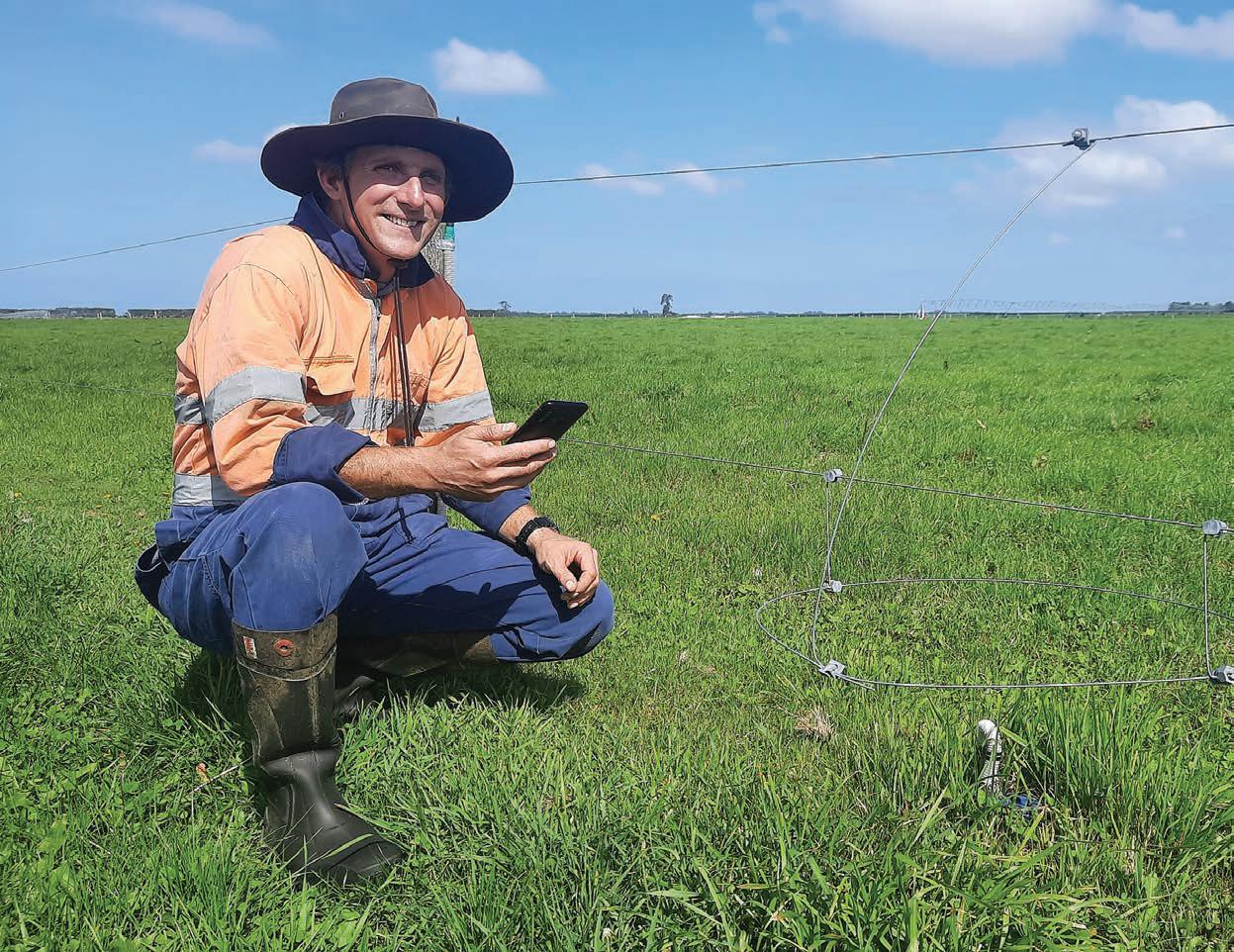
4 minute read
New Thinking
A better sense of our water
Turning an irrigation sensor into an onboard agronomist is helping Canterbury-based Dairy Holdings hit some ambitious water saving targets, while also growing more feed using less fertiliser. Richard Rennie spoke to CropX New Zealand managing director Eitan Dan on how the company’s technology is setting new pastoral irrigation standards.
SOIL moisture sensors that are a complete redesign on traditional versions, backed by AI ability delivering information that is easy to understand, have contributed to Dairy Holdings slicing its water use across 20,000ha by a third since 2017.
New Zealand remains the only country in the world at this stage to have the sensors used to measure moisture relative to rye grass and clover, rather than for broadacre crops, but the conversion for Dairy Holdings has been relatively quick.
Initially, Dairy Holdings was seeking a standardised, automated and easily-accessible soil moisture monitoring system to optimise its irrigation systems and installed three CropX sensors on one farm to trial.
Within a year the company had 170 sensors rolled out across its 60 properties, with a further 180 to come.
Eitan Dan of CropX says while the technology for moisture sensing linked to irrigation decision making is not new, the older tech is bedevilled by issues that make it inflexible and difficult to use.
“You will usually have a moisture strip physically buried in the soil down to about a metre and of course maintenance is an issue. They tend to be five times more expensive, but by far the biggest difference is they are not backed by any AI technology.”
Dairy Holdings’ own experience with the old technology had also found it to be time consuming and delivered inconsistent results.
While this tech could generate graphs of moisture and losses, it required someone to interpret it to act on that data.
The CropX sensors, backed by AI, have the ability to learn from irrigation events in terms of water loss and movement through the soil, with 95% accuracy.
“From there, the system can tell the user how much water needs to be applied, and when, combining data from weather information, the soil moisture, soil type and the irrigation system.”
Learning algorithms are based off the input and modelling CropX’s agronomists and data scientists apply, presenting it in a form that is easily understood by the user.
Dan says the Dairy Holdings system would be the biggest, most comprehensive irrigation monitoring network on the company’s books and the company has made a point of putting water and fertiliser conservation at the forefront, with effluent application the next to be incorporated.
“And we are proud of the fact Dairy Holdings will on-board any new farm managers with a focus on using precision agriculture tech, made easier by this being simple to use.”
Since installing the network, Dairy Holdings has also reduced fertiliser use to within the new nitrogen cap regulations of 190kgN per hectare, at an average of 172kgN/ha for the 2021-22 season.
Meantime, pasture production has increased, with a significant 90% decline in the quantity of purchased supplement bought into the system each year.
The company folded NZ agritech company Regen into its structure to combine Regen’s irrigation tech focus into CropX’s farm sensor and information generation capability to deliver a sensor that goes beyond simple moisture detection.
The CropX’s sensor was first launched at last year’s Mystery Creek Fieldays and was a finalist in the innovation awards.
It has the ability to measure not only moisture, but also temperature and electrical conductivity.
The conductivity measurement means the sensors can also provide an indication of any leaching events that may move recently added fertiliser nutrients beyond the soil root zone.
The AI’s ability to learn from the soil’s response to irrigation and rainfall means leaching and water loss events can be alerted to, helping minimise fertiliser losses while also conserving water.
Having only been in NZ since arriving from Israel 18 months ago, Dan says rural NZ is blessed with particularly good internet connectivity, making IoT tech very installable.
“Of the Dairy Holdings sensor locations, we only had two out of 200 that initially could not be hooked up, and only required a small relocation to work.”
The sensors record the soil’s status every half an hour and reassesses its irrigation recommendations every 12 hours.
“It is basically like having your own agronomist there online offering the most up to date advice.”
Dan says as NZ farmers are compelled to also understand their greenhouse gas emissions better and CropX is doubling down on how its sensor tech can contribute.
“For example, if you apply fertiliser at the wrong time, at the wrong temperature it can be 10 times more polluting.”
Dairy Holdings chief executive Colin Glass says the CropX system has provided the corporate farmer with simplicity at scale.
“It allow for more confident decision making and brings greater transparency across our farms. This means our farm managers can learn from each other to further enhance efficiencies and we can take a standardised approach to data management and reporting.”
SMARTER: Dairy Holdings farm manager Shaun Wise using CropX app for irrigation monitoring.
Eitan Dan CropX

Kickstarting students agricultural careers at Feilding High School
Feilding High School is leading the way in preparing students for the diverse opportunities that come with a career in the primary sector. Watch the video now at youtube.com/OnFarmStory This episode was made possible with support from






